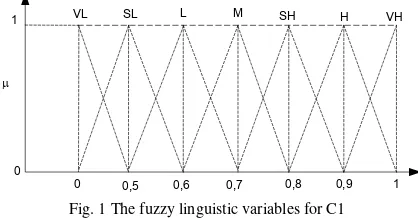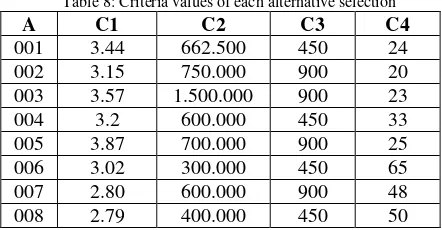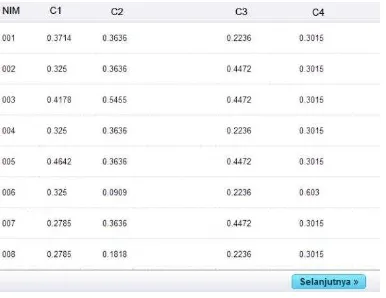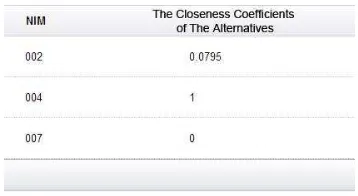Multi-Attribute Decision Making Scholarship Selection Using
A Modified Fuzzy TOPSIS
Gusti Ayu Made Shinta Wimatsari1, I Ketut Gede Darma Putra2 and Putu Wira Buana3 1
Department of Information Technology, Udayana University Bali, 80361, Indonesia
2
Department of Information Technology, Udayana University Bali, 80361, Indonesia
3
Department of Information Technology, Udayana University Bali, 80361, Indonesia
Abstract
This research demonstrates the scholarship selection with cases in Udayana University, Bali, Indonesia by using Fuzzy Multi Attribute Decision Making (FMADM) with the method TOPSIS. TOPSIS method is a method of support decision that is based on the concept with the best alternative that is not only has the shortest distance from the positive ideal solution but also it has the longest distance from the negative ideal solution. Selection of recommended students who have the highest level of eligibility for the scholarship based on the value preferences held. The final results of this study provide the ranking of the largest to the smallest value of the calculation method FMADM TOPSIS that can help decision-making selection of scholarship at Udayana University.
Keywords: Criteria, Distance, Scholarship Selection, Eligibility, Topsis.
1. Introduction
Scholarship finance is not sourced from its own funding or parents, but provided by the government, private companies, embassies, universities, and non-educators or researchers. Scholarships are given to the right receiver, especially based on classification, quality and competence of the recipients. [2]
Scholarships are also awarded to students at the University of Udayana, Bali, Indonesia. Selection of the scholarship will be difficult and takes a long time because of a lot of scholarship applicants and the criteria that is used to determine scholarship decisions as expected. Data management in the selection of the scholarship has not been fully optimized leading to difficulties in processing the data, and the length of the delivery of information results from the scholarship selection.
This research is expected to assist in the selection of scholarship at the University of Udayana, and assist students in determining the type of scholarships that match the values of criteria. Assessment of selection based on the value of criteria from the student.
This study uses fuzzy MADM (Multi Attribute Making Decision) with Technique for Order Preference by Similarity to Ideal Solution (TOPSIS) method. TOPSIS is a decision support method which is based on the concept the best alternative and not only has the shortest distance from the positive ideal solution but also it has the longest distance from the negative ideal solution. Decision support system of scholarship selection will recommend the type of scholarships for student at capacity scholarship and value of criteria.
2. Previous Research
Kamran Shahanaghi and Seyed Ahmad Yazdian develop a model vendor selection using a new fuzzy group TOPSIS approach. The research presented a new Fuzzy Multi Criteria Group Decision Making (FMCGDM) approach for vendor (supplier) selection problem. The proposed approach is based on TOPSIS method under fuzzy environment to account for vagueness and uncertainty of the real-world situations [13].
Pragati Jain and Manisha Jain develop a model fuzzy TOPSIS method in job sequencing problems on machines of unequal efficiencies. The research presented the way of making sequence of a finite number of jobs on a finite number of machines of unequal efficiencies by using the technique of order preference by similarity to ideal solution or simply TOPSIS Method in fuzzy environment. The order of machines is random. The time taken by the machines for conducting jobs is assumed as imprecise processing time or fuzzy numbers [14].
A.R. Karimi, N. Mehrdadi, S.J. Hashemian, Gh.R. Nabi-Bidhendi and R. Tavakkoli-Moghaddam develop a model by using the fuzzy TOPSIS and fuzzy AHP methods for wastewater treatment process selection. The research investigated five different anaerobic wastewater treatment processes operated in Iranian industrial estates. The criteria evaluation and priorities of alternatives have been done by fuzzy TOPSIS and fuzzy AHP methods by the use of triangular fuzzy numbers. Finally, selection of these five processes is ranked by these foregoing methods, in which their differences are discussed [15].
3. The Advantages of Scholarship Decision
Support System
Technological developments are adopted to facilitate the selection process of the scholarship recipients at the University of Udayana in particular. Decision support system allows grantee selection process in a short time and in accordance with the requirements of the scholarship recipients are offered a scholarship provider. Candidates inserts the value of the criteria into the system. The next step is processing the value in the method of Fuzzy MADM TOPSIS. The output of the system is the closeness coefficients of the alternatives ranked from the largest value to the smallest value. The ability of the system provides assessment of results the scholarship selection using by FMADM TOPSIS. The results display the name of the candidates / ID candidates, the closeness coefficients of the alternatives, the rank of the closeness coefficients of the alternatives, and the type of scholarships received by the candidate. Mistakes in the selection process will be reduced by the use of a decision support system compared to manually selection. and imprecise terms. Fuzzy set theory treats vague data as probability distributions in terms of set memberships. Once determined and defined, sets of memberships in probability distributions can be effectively used in logical reasoning.
4.2 Fuzzy Multi Attribute Decision Making
(MADM)
Determination of the decision in the case of Multi-Attribute Decision Making (MADM), resolved by selecting the best alternative out of several alternatives. However, because the data are used appropriately, it can’t be expressed in crisp; the method used is an advanced development of the MADM methods.
This development method called the Fuzzy Multi Attribute Decision Making (FMADM), where the application of fuzzy logic method is applied. The essence of FMADM is to determine weights for each attribute, followed by a ranking process will select the alternative that has been given.
The method can be used to solve the problem FMADM [4]:
1. Simple Additive weighting method (SAW) 2. Weighted Product (WP)
3. ELECTRE
4. Analytic Hierarchy Process (AHP)
5. Technique for Order Preference by Similarity to Ideal Solution (TOPSIS)
4.3 Linguistic Values
1. Normalized decision matrix
Each element of the matrix D is normalized to obtain the normalization matrix R. Each normalized value rij
can be calculated as follows:
rij =
can be calculated as follows:
Y =
w11r11 w1nr1n
⋱
wm 1rm 1 wnmrnm ... (2) where i=1,2,3,…,m and j=1,2,3…,n
3. Determine the positive ideal solution and negative ideal solution
Separation measure is a measurement of the distance of an alternative to the positive ideal solution and negative ideal solution. Mathematical calculation is as follows:
Separation measure to the positive ideal solution D+i = nj=1(Yij−Yj+)2 where i = 1,2,3,…, n... (5)
Separation measure to the negative ideal solution D−i = nj=1(Yij−Yj−)2 where i = 1,2,3,…, n... (6)
5. Calculating the relative closeness to the positive ideal. Relative closeness of the alternative A+ to A -ideal solution represented by:
Vi= Di− Di−+Di+
, where 0 < Vi< 1 and i = 1,2,3,…m... (7)
6. Sorting Preference
Alternatives can be ranked based on the order of
Problem-solving and computation scholarship selection with TOPSIS method described as:
Phase 1: Collect the number of alternatives that will be used and some of the attributes or criteria. There are four criterias used as a basis for making decisions in the selection of scholarship that is used at Udayana University, Bali, Indonesia. The criteria are:
C1 = GPA (Grade Point Average)
C2 = quotient of income parents by the number of dependents
C3 = The Usage of Electrical Power C4 = Student Activities
Scholarship recipients at Udayana University, Bali Indonesia selected from alternatives that fulfill all the administrative requirements of the type of scholarship that is being selected. One example of scholarship that is selected Academic Improvement Scholarship (PPA). Administrative requirements of the PPA scholarships to students in order to qualify for the scholarship selection are:
1. Achievement will be given by considering the background of the economic capacity of parents to their students,
2. Student minimum was in the second semester and the highest was in eighth semester,
3. Attach files as Student Identity Card Copy (KTM) and Card Study Plan (KRS) or similar as proof of active student,
4. Copy of last electric bill and proof of payment or the United Nations of a parent / guardian,
5. Statement that is not currently receive any scholarships from other sources in the environment known to the Ministry of National Education Leadership Education high Student Affairs,
6. Copy of family card, recommendation from the head of the Faculty / Department,
7. Copy of academic transcript with a grade point average (GPA) of at least 3.00 were endorsed by the leadership of the college,
8. Income certificate of parents and approved by the authorities. [9]
Other scholarships offered a scholarship at the University of Udayana is Underprivileged Scholarship. The requirements Underprivileged Scholarship almost equal to the achievement Scholarship Requirements, but there are differences in the number of GPA. Total minimum GPA for Underprivileged Scholarship is 2.75. The purpose of the scholarship selection is to get some of the candidates who fulfill the administrative requirements specification. For the example in this research, use 8 students (alternatives) that are listed in the scholarship selection. Of 8 students (alternatives) will be selected by FMADM TOPSIS method.
Phase 2: Assessment of Fuzzy Sets
Table 1: Assessment of Fuzzy Sets
Low 0, 0.3, 0.6
Medium 0.3, 0.6, 0.9
High 0.6, 0.9, 1
Table 2: Linguistic variables for the importance weight of each criteria for Achievement scholarship
Table 3: Linguistic variables for the importance weight of each criteria for Underprivileged scholarship element represented by using triangular fuzzy value with VL = Very Low, SL= Slightly Lower, L=Low, M=Medium, SH= Slightly Higher, H=High, VH=Very High. The value of each membership function will be showed in Fig. 1 and Table 4.
Table 4: Fuzzy linguistic terms and their correspondent fuzzy numbers for C1
Fig. 1 The fuzzy linguistic variables for C1
Quotient of parent income by the number of dependents criteria (C2) by using suitability degree with several alternative decisions: T (suitability) = {S, M, RB, B, VB, VVB}. Membership functions of each element represented by using triangular fuzzy value with S=Small, M=Moderate, RB=Rather Big, B=Big, VB=Very Big, VVB=Very Very Big. The value of each membership function will be showed in Figure 2 and Table 5.
Table 5: Fuzzy linguistic terms and their correspondent fuzzy numbers for C2
Range C2 (IDR) Linguistic
Variable Fuzzy Number
Fig. 2 The fuzzy linguistic variables for C2
Table 6: Fuzzy linguistic terms and their correspondent fuzzy numbers
Fig. 3 The fuzzy linguistic variables for C3
Student activities (C4) by using suitability degree with several alternative decisions: T (suitability) = {VL, L, M, H, VH}. Membership functions of each element represented using triangular fuzzy value with VL=Very Low, L=Low, M=Medium, H=High, VH=Very High. The value of each membership function will be showed in Figure 4 and Table 7.
Table 7: Fuzzy linguistic terms and their correspondent fuzzy numbers for C4
Fig. 4 The fuzzy linguistic variables for C4
5. Experiments and Results
The output of this research is result of scholarship selection which is sorted from highest value of the closeness coefficient of alternative to lowest value of the closeness coefficient of alternative and based on quota of recipients the type of scholarship offered. The final
results were implemented in a decision support system scholarship selection based on input the values of criteria are and processed using TOPSIS FMADM. The scholarship selection process in this research using two types of scholarships are Achievement Scholarship and Underprivileged Scholarship. The number of candidates is used as an example of the data is 8 students. Scholarship capacity of Achievement Scholarship is 5 students and Underprivileged scholarship is 3 students.
First step, decision support system will process and recommend the Achievement Scholarship to 5 students which is have high value of the closeness coefficient of alternative. The candidates who do not fulfill capacity and requirements of Achievement Scholarship will be recommended to Underprivileged Scholarships. Table 8 shows the criteria values of each alternative. Value criterion is used as the input of the scholarship selection.
Table 8: Criteria values of each alternative selection
A C1 C2 C3 C4 on each criterion. These values are used for the decision matrix normalization process in the next step.
Table 9: Value rating compatibility based on value criteria
Fig. 5 The result of normalized decision matrix calculation
Figure 6 shows the results of the normalized weighted matrix. Each criterion to get a certain weight value in which case the GPA (C1) criteria and student activities (C4) using a higher weight than the other criteria.
Fig. 6 The result of calculate normalized matrix has been weighted
Calculation of positive ideal solution using equation 3, and the negative ideal solution using equation 4. The result of this process produces the value as shown in figure 7.
Fig. 7 The result of calculated positive and negative ideal solutions
The next step as showed in figure 8 are positive and negatives to determine the distance of each alternative. Determination positive distance using equations 5 and negative distance using equation 6.
Fig. 8 The result of calculated the positive and negative distance
The next step is by calculating the closeness coefficients of the alternatives using equation 7. The results of the five alternatives are obtained as shown in Figure 9.
Fig. 9 The result of calculated the closeness coefficients of the alternatives.
Fig. 11 The final result of TOPSIS methods for Achievement Scholarship
The final step in the selection of Achievement Scholarship is adjusting capacity of recipients. In this research Achievement Scholarships capacity is 5 receiver. So, the five candidates who have five highest score was selected as the recipient of a scholarship achievement. While, the lowest 3 candidates will be recommended to the Underprivileged Scholarship. Fig. 10 show the highest rank owned by the student ID/NIM 006 with value 0.7146 and the lowest rank value is 0.2854 that is owned by student ID/NIM 003. First rank was achieved by student ID/NIM 006 with value of the closeness coefficient of alternative is 0.7146. The values of criterion are C1 = 3.02, C2 = IDR 300.000, C3 = 450VA and C4 = 65. This alternative has the highest eligibility for Achievement Scholarship selection when compared to other alternatives.
Second rank was achieved by student ID/NIM 005 has value of the closeness coefficient of alternative is 0.3764. The values of criterion are C1 = 3.87, C2 =IDR 700.000, C3=900VA and C4 = 25. Assessment achievement scholarship is prioritized to criteria C1 and C4.
Student ID/NIM 001 has value of criterion C1 = 3.44, C2 = IDR. 662.500, C3 = 450VA and C4 = 24. The value of the closeness coefficient of alternative is 0.2894 and this alternative is the third rank.
Selection of Achievements Scholarship have been completed. Then the system will process the Underprivileged Scholarship. From the previous selection, three students failed in the selection of Achievement Scholarship. Three students who are recommended by the the decision support system in the next scholarship selection.
Table 8 will be showed the value of the criteria of the three candidates who failed the selection of achievement scholarships and will go to the Underprivileged Scholarship selection.
Table 8: Criteria values of each alternative selection
A C1 C2 C3 C4
002 3.15 750.000 900 20
004 3.2 600.000 450 33
007 2.80 600.000 900 48
Table 9: Value rating compatibility based on value criteria
A C1 C2 C3 C4
002 0.7 0.4 0.4 0.2
004 0.7 0.4 0.2 0.2
007 0.6 0.4 0.4 0.2
Figure 12 shows the results of the normalized matrix using equation 1. As the phase in the selection of Achievement Scholarship, the results of the calculation criteria matrix obtained results in the form of normalization. The next step in this research is the weighting matrix using equation 2.
Fig. 12 The result of normalized decision matrix calculation the Underprivileged scholarship
Figure 13 shows the results of the normalized weighted matrix. Each criterion to get a certain weight value in which case criteria C2 and C3 using a higher weight than the other criteria.
Fig. 13 The result of calculate normalized matrix has been weighted the Underprivileged scholarship
Calculation of positive ideal solution using equation 3, and the negative ideal solution using equation 4. The result of this process produces the value as shown in figure 14.
Fig. 14 The result of calculated positive and negative ideal solutions the Underprivileged scholarship
Fig. 15 The result of calculated the positive and negative distance the Underprivileged scholarship
The next step is by calculating the closeness coefficients of the alternatives using equation 7. The results of the five alternatives are obtained as shown in Figure 16.
Fig. 16 The result of calculated the closeness coefficients of the alternatives the Underprivileged Scholarship
Fig. 17 The result of ranks from the value of closeness coefficients of the alternatives the Underprivileged scholarship
Figure 17 shows the results of the ranks selection. In this research the case of types of Underprivileged Scholarships have a capacity of three recipients. Therefore, all candidates in fig. 17 awarded the Underprivileged Scholarships.
Fig. 18 The final result of TOPSIS methods for achievement scholarship the Underprivileged scholarship
Figure 18 shows the the final result of Underprivileged Scholarship selection. First rank was achieved by student ID/NIM 004 with value of the closeness coefficient of alternative is 1. The values of criterion are C1 = 3.2, C2 = IDR 600.000, C3 = 450VA and C4 = 33.
This alternative has the highest eligibility for scholarship selection achievement when compared to other alternatives.
Assessment Underprivileged Scholarship is prioritized to criteria C2 and C3. Second rank was achieved by student ID/NIM 002 has value of the closeness coefficient of alternative is 0.0795. The values of criterion are C1 = 3.15, C2 =IDR 750.000, C3=900VA and C4 = 20. The third rank was achieved by student ID/NIM 007 has value of the closeness coefficient of alternative is 0. The values of criterion are C1 = 2.80, C2 =IDR 6000.000, C3=900VA and C4 = 48.
4. CONCLUSION
This study has successfully obtained a scholarship recipient selection results by using the Fuzzy Multi Attribute Decision Making Technique for using Order Preference by Similarity to Ideal Solution (TOPSIS). In this study, several criteria were used GPA (Grade Point Average), quotients of income parents by the number of dependents, number of dependents parents, the usage of electrical power and student activities.
Scholarship selection process is done by normalizing the value of each criteria in a decision matrix, multiplies by weight according to the degree of influence of each criteria in the selection process, the calculation of the positive and negative ideal solution of each of the criteria, calculating the distance from the positive alternative negative, calculate the relative closeness to the positive ideal, and the last is the rank of the selection results. The selection recommend an alternative that has the highest level of eligibility to the most low to get a scholarship based on value preferences held.
Acknowledgments
Our thank goes to Department of Information Technology Udayana University, Bali, who has helped organize this research's Indonesia.
REFERENCES
[1] Hwang, C.L. and Yoon, K. (1981). Multiple Attribute Decision Making Methods and Applications. Springer, New York, NY.
[2] Gafur, Abdul. 2008. Cara Mudah Mendapatkan Beasiswa. Jakarta, Indonesia. Penebar Plus Publisher
[3] Uyun, Shofwatul, and Imam, Riadi. A Fuzzy Topsis Multiple-Attribute Decision Making for Scholarship Selection. TELKOMNIKA, Vol.9, No.1, April 2011, pp. 37~46.
[5] Zadeh, L. A. “Fuzzy sets. Information and Control”, Vol. 8, pp. 338-353. 1965.
[6] Ding, Ji-Feng. An Integrated Fuzzy Topsis Method For Ranking Alternatives And Its Application. Journal of Marine Science and Technology, Vol. 19, No. 4, pp. 341-352 (2011)
[7] Zadeh, L. A., “The concept of a linguistic variable and its application to approximate reasoning, Part 1, 2 and
3,” Information Sciences, Vol. 8, No. 3, pp. 199-249 (1975); Vol. 8, No. 4, pp. 301-357 (1975); Vol. 9, No. 1, pp. 43-80 (1976).
[8] Chang, P. L. and Chen, Y. C., “A fuzzy multi-criteria decision making method for technology transfer strategy
selection in biotechnology,” Fuzzy Sets and Systems, Vol. 63, No. 2, pp. 131-139 (1994).
[9] Dikti. 2010. Pedoman Beasiswa Peningkatan Prestasi Akademik (PPA) dan Bantuan Belajar Mahasiswa (BBM). Jakarta, Indonesia.
[10] S. J. Chen and C. L. Hwang, Fuzzy Multiple Attribute Decision Making, (Lecture Notes in Economics and Mathematical System Series 375). Springer-Verlag. New York, 1992.
[11] TIEN-CHIN, WANG. HSIEN-DA, LEE.
CHUAN-CHENG, WU., “A Fuzzy TOPSIS Approach with Subjective Weights and Objective Weights,”
Proceedings of the 6th WSEAS International Conference on Applied Computer Science, Hangzhou, China, April 15-17, 2007
[12] K.Savitha, DR.C.Chandrasekar., “Network Selection Using TOPSIS in Vertical Handover Decision Schemes for Heterogeneous Wireless Networks”. IJCSI International Journal of Computer Science Issues, Vol. 8, Issue 3, No. 2, May 2011
[13] Kamran Shahanaghi. Seyed Ahmad Yazdian. “Vendor Selection Using a New Fuzzy Group TOPSIS
Approach”. Journal of Uncertain Systems Vol.3, No.3, pp.221-231, 2009
[14] Pragati Jain and Manisha Jain. “Fuzzy Topsis Method In Job Sequencing Problems On Machines Of Unequal
Efficiencies”. Canadian Journal on Computing in Mathematics, Natural Sciences, Engineering and Medicine Vol. 2 No. 6, June 2011
[15] A.R. Karimi, N. Mehrdadi, S.J. Hashemian, Gh.R. Nabi-Bidhendi, and R. Tavakkoli-Moghaddam “Using Of The Fuzzy Topsis And Fuzzy Ahp Methods For Wastewater
Treatment Process Selection”. International Journal of Academic Research vol. 3. No. 1. January, 2011, part III
Gusti Ayu Made Shinta Wimatsari studied Information
Technology in Department of Information Technology Udayana University since August 2008, and now working her research for S.Ti. degree in Information Technology.
Dr. I Ketut Gede Darma Putra, S.Kom., MT received his
S.Kom degree in Informatics Engineering from Institut Teknologi Sepuluh Nopember University, his MT. degree in Electrical Engineering from Gajah Mada University and his Dr. degree in Electrical Engineering from Gajah Mada University. He is lecturer at Electrical Engineering Department (major in Computer System and Informatics) of Udayana University, lecturer at Information Technology Department of Udayana University.
Putu Wira Buana, S.Kom., MT received his S.Kom degree in



